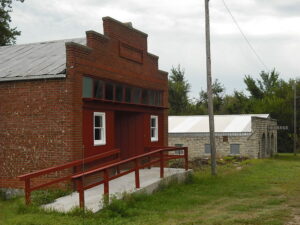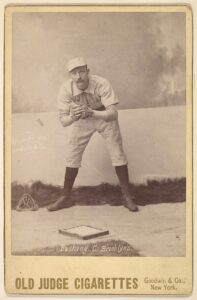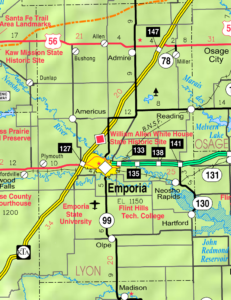 The “almost” ghost town of Bushong, Kansas got its start in 1886 when the Missouri Pacific Railroad built its tracks across Northern Lyon County. The railroad station was named Weeks, as was the town at first, after Joseph Weeks, who donated 20 acres of land to the railroad. After the railroad built on part of the acreage, it sold some of the acreage as town lots. Although there was no town company, per se, Joseph Weeks also platted another 20 acres and sold lots on that, and a town was born. The Missouri Pacific Railroad also built a large tank pond one mile east of town to supply the steam engines with water, as they pulled their trains over the hills to Council Grove. There were large pastures filled with cattle in the area, and cattle pens were constructed to hold the cattle for shipping. The railroad also bought a valuable stone quarry south of Bushong and shipped quarried rock to Kansas City, about an hour and a half to their Northeast.
The “almost” ghost town of Bushong, Kansas got its start in 1886 when the Missouri Pacific Railroad built its tracks across Northern Lyon County. The railroad station was named Weeks, as was the town at first, after Joseph Weeks, who donated 20 acres of land to the railroad. After the railroad built on part of the acreage, it sold some of the acreage as town lots. Although there was no town company, per se, Joseph Weeks also platted another 20 acres and sold lots on that, and a town was born. The Missouri Pacific Railroad also built a large tank pond one mile east of town to supply the steam engines with water, as they pulled their trains over the hills to Council Grove. There were large pastures filled with cattle in the area, and cattle pens were constructed to hold the cattle for shipping. The railroad also bought a valuable stone quarry south of Bushong and shipped quarried rock to Kansas City, about an hour and a half to their Northeast.
As the town grew, more buildings were needed. The first school building was erected in 1886. The school was a two-story wood-frame structure, and it housed grades 1-8. The school was used until 1948. Then, students were moved to the brick high school building, and the old school building was sold and removed. When the new settlement gained a post office on January 31, 1887, the name was changed to Bushong in honor of Al “Doc” Bushong, who was a baseball player for the Saint Louis Browns. The player’s greatest success came when he was the starting catcher in the 1886 World Series. The Saint Louis Browns of the American Association beat the Chicago White Stockings of the National League. The team owner wanted to do something special for his team to mark their success. Somehow, he made the arrangements for each player to have a town named after them. While all the players had towns named after them, Bushong is the only town that still carries the name of the player they were to have honored. In 1887, Bushong had a population of about 75 people. The first station agent was R D Cottrell, who also built the Bushong Hotel, which he operated with his wife until his death, then she remarried and continued to operate the hotel for a few more years. Other early businesses included a general store, a flour mill, blacksmith, lumber yard, boarding house, and a hog fence factory.
In the town’s saddest event, twelve members of the population died within 48 hours of each other in February 1894, when a diphtheria epidemic gripped the town. It was the last great pandemic of the 19th century, and among the deadliest pandemics in history. The worst effects of the pandemic took place from October  1889 to December 1890, with recurrences in March to June 1891, November 1891 to June 1892, winter of 1893–1894, and early 1895. At the same time, the school in Bushong was closed. The towns first and only doctor, Chester L Stocks, set up his practice in 1896. He was also a druggist, and he continued to serve the community until 1934.
1889 to December 1890, with recurrences in March to June 1891, November 1891 to June 1892, winter of 1893–1894, and early 1895. At the same time, the school in Bushong was closed. The towns first and only doctor, Chester L Stocks, set up his practice in 1896. He was also a druggist, and he continued to serve the community until 1934.
For a brief time in 1899, the town boasted a newspaper called the Bushong Bulletin. It was a small town, and really, how much news could there be. A Methodist church was established that year. It had one large room with a pot-bellied stove in the center and an organ. By 1910, Bushong was a thriving town with a population of 250. The post office even had one rural route. The town also had a number of general stores, a hotel, public school, telegraph, telephone, and express service, and its railroad was providing a considerable amount of shipping. For many years trains stopped at Bushong for passengers. When passenger service was discontinued, trains could still be stopped by “flagging” them down to load freight or livestock. It finally became necessary to establish the Bushong Rural High School, and classes were held in the upper room of the grade school in 1913. Later, students were taught in other town buildings, with the first graduation taking place in 1916. The town also became home to The Bushong State Bank, which was chartered in 1916, but like many other banks, it failed during the Great Depression and closed in 1932. A new brick High School was erected in 1918 consisting of four rooms. Later additions were made, including a gymnasium in 1926. Unfortunately, a fire in the 1920s destroyed a large portion of the downtown area, and the buildings were never rebuilt. In 1923 a new Methodist church building was erected on the same site as the first one. The building utilized the bell from the old church in the belfry. That year, the town’s population was 150. However, the next year, severe drought and heat caused many settlers to move from the area. Bushong was incorporated in 1927, and L A Grimsley was elected as the first mayor. At that time, the town had a population of about 150 and continued to maintain its two room grade school and a four-room rural high school. The Methodist Church and Sunday School were well attended. At about that same time, electricity was approved, and in 1936 Bushong voted to sell their utility to Kansas Electric Company of Emporia. Bushong’s early telephone system was part of the Farmers Mutual Telephone Association, a cooperative company that everyone helped to construct and care for lines and poles. The telephone company was sold in 1960. Like numerous other communities, Bushong was hit hard by the Great Depression and never recovered.
In 1955, school enrollment had dropped to such a degree that Bushong consolidated with the other area schools. High school pupils went to nearby Allen until Northern Heights opened in the fall of 1957, consolidating the high schools of Bushong, Allen, Admire, and Miller. Grade school continued at Bushong until 1966 when all area 3rd and 4th graders went to Bushong and the other grades to Allen and Admire. The school finally closed  in 1970, and the city purchased the building for use as a Civic Center. Currently, the building is abandoned. The railroad discontinued the depot in 1957, and later the depot building was torn down.
in 1970, and the city purchased the building for use as a Civic Center. Currently, the building is abandoned. The railroad discontinued the depot in 1957, and later the depot building was torn down.
During the Cold War, Bushong was again in the spotlight. I became the location of one of the first generations of nuclear-tipped intercontinental ballistic missiles. One of several Atlas class missile silos developed in the Midwest, active from 1961-1965, was part of the 548th Strategic Missile Squadron was located in the small town. Unfortunately, that was still not enough to save the town from virtual extinction. Bushong’s post office closed on July 2, 1976. Today, Bushong is called home to only about 30 people with no open businesses. The old community is located about 20 miles northwest of Emporia. It’s strange how things work out. What starts out as a thriving town, sometimes gives way to a ghost town, while other times, the town grows to greatness.


Leave a Reply